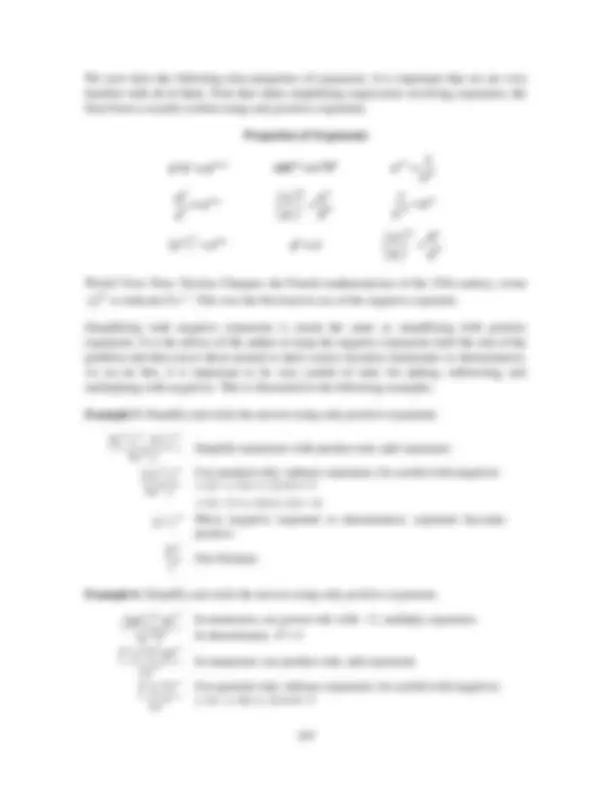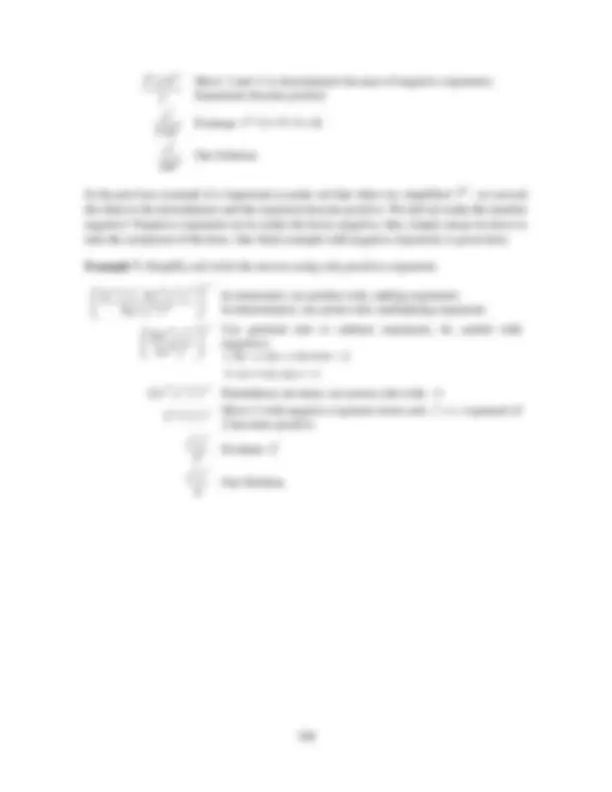







Study with the several resources on Docsity

Earn points by helping other students or get them with a premium plan


Prepare for your exams
Study with the several resources on Docsity

Earn points to download
Earn points by helping other students or get them with a premium plan
Community
Ask the community for help and clear up your study doubts
Discover the best universities in your country according to Docsity users
Free resources
Download our free guides on studying techniques, anxiety management strategies, and thesis advice from Docsity tutors
Examples and rules for simplifying expressions with negative exponents. It covers the zero power rule, the property of negative exponents yielding the reciprocal of the base, and the rules for combining negative exponents. The document also includes examples for simplifying expressions using these rules.
Typology: Slides
1 / 9

This page cannot be seen from the preview
Don't miss anything!






Objective: Simplify expressions with negative exponents using the properties of exponents.
There are a few special exponent properties that deal with exponents that are not positive. The first is considered in the following example, which is written out in two different ways.
Example 1. Simplify.
3 3
a a
Use quotient rule; subtract exponents
a^0 Our Solution; now consider the problem in the second way 3 3
a a
Rewrite exponents; use repeated multiplication aaa aaa
Our Solution; combine the two solutions, get: a^0^ 1 Our Final Solution
This final result is an important property known as the zero power rule of exponents.
Zero Power Rule of Exponents: a 0 = 1
Any non-zero number or expression raised to the zero power will always be 1. This is illustrated in the following example.
Example 2. Simplify.
(3 x^2 )^0 Zero power rule
property we will consider here deals with negative exponents. Again we will solve the following example in two ways.
Example 3. Simplify and write the answer using only positive exponents.
5
a^3 a
Use quotient rule; subtract exponents
a ^2 Our Solution; solve this problem another way
5
a^3 a
Rewrite exponents; use repeated multiplication aaa aaaaa
aa
Simplify to exponents
2
a^ Our Solution; combine the two solutions; get: 2 2 a^1 a
(^) Our Final Solution
This example illustrates an important property of exponents. Negative exponents yield the reciprocal of the base. Once we take the reciprocal, the exponent is now positive. Also, it is important to note that a negative exponent does not mean that the expression is negative; only that we need the reciprocal of the base. The rules of negative exponents follow.
Rules of Negative Exponents:
Negative exponents can be combined in several different ways. As a general rule, if we think of our expression as a fraction, negative exponents in the numerator must be moved to the denominator; likewise, negative exponents in the denominator need to be moved to the numerator. When the base with exponent moves, the exponent is now positive. This is illustrated in the following example.
Example 4. Simplify and write the answer using only positive exponents.
3 2 2 1 4 2
a b c d e f
Exponents become positive 3 4 2 2 2
de b
c f
a Our Solution
As we simplified our fraction, we took special care to move the bases that had a negative exponent, but the expression itself did not become negative because of those exponents. Also, it is important to remember that exponents only effect the base they are attached to. The 2 in the denominator of the above example does not have an exponent on it, so it does not move with the d.
-m^1 a = am (^1) m a-m^ = a
-m (^) m = m a b b a
(^) a b Move 3 and b to denominator because of negative exponents; Exponents become positive 3 3 2^2
a b
Evaluate3 ^2 2 92 18 3 18 9
a b
Our Solution
In the previous example it is important to point out that when we simplified 3 ^2 , we moved the three to the denominator and the exponent became positive. We did not make the number negative! Negative exponents never make the bases negative; they simply mean we have to take the reciprocal of the base. One final example with negative exponents is given here.
Example 7. Simplify and write the answer using only positive exponents.
2 5 3 6 2 3 3 2 2 3
x z x
y x y z y
^
In numerator, use product rule; adding exponents In denominator, use power rule, multiplying exponents 8 3 0 3 6 6
x y z x y
Use quotient rule to subtract exponents, be careful with negatives: ( 8) ( 6) ( 8) 6 2 3 6 3 ( 6) 3
(2 x ^2 y ^3 z^0 )^3 Parentheses are done; use power rule with 3 2 ^3 x y z^6 9 0 Move 2 with negative exponent down and^ z^^0 ^1 ; exponent of 2 becomes positive 6 9 23
x y Evaluate 23
6 9 8
x y Our Solution
Simplify each expression. Your answer should contain only positive exponents.
2 x^4 y ^2 ( 2 xy^3 )^4
2 a ^2 b ^3 ( 2 a^0 b^4 )^4
( a^4 b ^3 )^3 2 a b^3 ^2
2 x^3^ y^2^ ( 2 x^3 )^0
(2 x y^2 2^ ) x ^4
( m^0^ n^3^ 2 m ^3 n ^3 )^0
( x^3^ y^4^ )^3 x ^4 y^4
2 m ^1 n ^3 (2 m ^1 n ^3 )^4
3 2 3 3 0
x y x y x
(^)
3 3 4 3
3 2 x
y yx y
3 4 0 1
x y x y y
3 2 2 2 4
y x y
x y ^ ^
2 1 2 0 4 2
v v uv
u u
2 3 4 4 4
x y y x
xy x
2 4 0 v^3
u u v
2 2 2
x y yx
( x y )
y
a b
2 3 4 1
2 ab a
3 3 2 3 2
2 3 3
a b b
cb a c
4 2 2 4 4 2 3
m p m
q p
q
4 2 1 3 2 3 1
( yx ) z
z x y z
3 0 4 2 3 2 0
( ) 2 p
mp n
n m p n
(^)
3.2 Answers
1)^32 x y^8
13 2
32 b a
15 11
2 a b 4)^2 x y^3
8)^325 m n
9)^2 9 y
5 2 7
y x
21 3 y x
8 5 4
y x
u v
7 2 2
x y
2 125
u v
y x
17)^27 y
16 2
a b
16 a b^12
8 4 4
y x